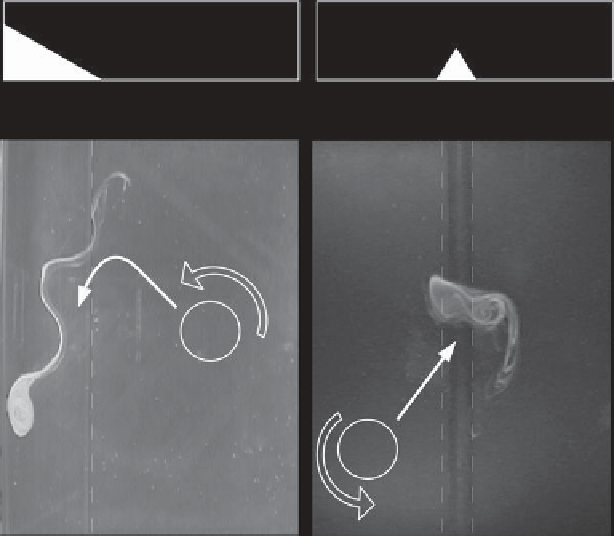Geoscience Reference
In-Depth Information
(a)
(b)
Steep slope
Side views
Ridge
Top views
Figure 7.5.
Dye photographs showing strong vortex-topography interactions in medium-scale rotating tanks. (a) Cyclonic vortex
over a steep slope at the “western” wall. Adapted from
Zavala Sansón and van Heijst
[2000b]. The vortex is forced to move to the
south, while meandering and being deformed over the slope. The domain is a 0.8 m
1.2 m rectangle. The width of the slope
is 0.23 m. The maximum fluid depth is 0.2 m, and the minimum depth at the western wall is 0.08 m. (b) Cyclonic vortex over
a topographic ridge. Adapted form
Zavala Sansón
[2002]. The domain is a 0.8 m
×
×
1.2 m rectangle. The width of the ridge is
0.1 m, and the height is 0.03 m. The maximum fluid depth is 0.21 m.
characteristics of the topographic feature as well as on
the vortex parameters. Some authors adopt a topographic
β
-plane in order to produce the drift of monopolar vor-
tices toward the obstacle, whereas in other studies the
vortices are initially generated over the variable topogra-
phy. Several cases were reviewed by
van Heijst and Clercx
[2009]. Here we underline two remarkable effects observed
in this type of experiment.
Strong vortex deformation:
An abrupt topographic fea-
ture is characterized by a typical height that is a sustan-
tial fraction of the total fluid depth. Such a condition
implies important stretching and squeezing effects on fluid
columns and therefore important changes in their relative
vorticity. This leads to a strong deformation of the vortices
and/or to clear deviations of their initial trajectory. Con-
sider, for instance, the fate of a cyclonic vortex impinging
a pronounced “western” slope as shown in Figure 7.5a.
The vortex is initialized far from the continental slope,
and it was made to drift to the northwest by the topo-
graphic
β
-effect of an additional overall weakly sloping
bottom. The photograph shows a dye visualization of
the vortex, which has been deflected to the south, being
strongly deformed, and leaving a meandering tail along
the topography. These meanders are so intense that they
may form new vortices. In fact, they are a manifestation of
very intense topographic Rossby oscillations, as described
in the previous section.
Another remarkable deformation is that of a cyclonic
vortex over a topographic ridge (Figure 7.5b). Initially
the circular vortex acquires a translating motion toward
the topography due to the influence of the closest slope.
Then it climbs to the top and the shape becomes ellipti-
cal, with the major axis perpendicular to the isobaths. The
vortex deformation when crossing the topography leads
to a remarkable event, namely, the vortex splitting in two
parts, one at each side of the ridge. The vortex elliptical
distortion can be understood by means of the topographic
Rossby radiation over the opposite slopes of the topogra-
phy, which are manifested by two anticyclonic cells that
strangulate the vortex (see Figures 10 and 11 in
Zavala
Sansón
[2002]). The remarkable distortions of the vortices
over abrupt topographies strongly suggest that these cases
should be treated under the shallow-water rather than the
quasi-geostrophic approximation.
















